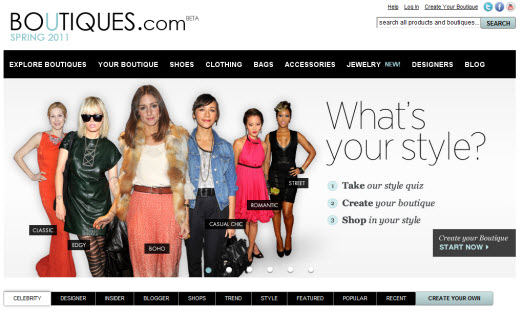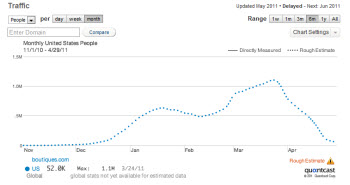Boutiques.com Traffic Drops 94% – Did Google Give Up On Fashion?

Last November Google lifted the curtain on Boutiques.com, the result of the search giant’s $100 million acquisition of Like.com, to great fanfare. All of the right fashion bloggers had their own boutiques on the site, as did a number of celebrities who appear as inspirations on those blogs. The New York launch party was attended by an A-list style set including Carey Mulligan and the Olsen twins among others.
Less than 6 months later, traffic to the site dropped off by 94%. In January, Google AdPlanner estimated Boutiques.com had 2.6 million visitors per month; in April, the estimate was 170,000 visitors. Even worse, it seems that no one noticed.
So what went wrong?
We often cover the intersection of fashion and tech, and as far as that goes the acquisition of Like and subsequent launch of Boutiques would seem to be a pretty big story, but we held off on covering it. As big as their acquisitions can be, Google’s track record on non-search products is actually very hit or miss. If you want an example of why talent + a big buyout doesn’t always equal success, look no further than the story of Dodgeball/Foursquare. The same people who built current mobile darling Foursquare sold a similar product called Dodgeball to Google in 2005, and left after about two years because Google didn’t support the project the way they had in mind. The fact that you now check in to Foursquare, and not Dodgeball, should tell you everything you need to know. For every YouTube, Google likely has 2 Dodgeballs; and if their drop in traffic is any indication Boutiques.com is likely going to have more in common with Dodgeball than YouTube.
We can’t offer any inside information on this story (contact us, if you can), but even from the outside looking in there are a few things that seem to smack of neglect and a business that ultimately just doesn’t fit with Google.
Google’s Social Manifesto
When Larry Page took over as CEO of Google, he made the importance of social abundantly clear to Google employees, tying 25% of their bonuses to the success of Google’s social strategy. {Business Insider} Google’s +1 button is the most recent iteration of a strategy that ties search and social together, but in addition to Boutiques not being mentioned in any company communications surrounding social, there’s not a single +1 button on any Boutiques page.
In one of the few critical pieces after last year’s launch, Fashionably Marketing listed a number of the site’s cons from a publisher perspective. “It’s going to be hard to get users to abandon other sites to be a part of the Boutiques.com community. There are limited social sharing features; you can email or Tweet about a boutique, and that’s it. Facebook was clearly left off because Google may want to compete with Facebook in the brand/customer engagement and sales arena later on,” editor Macala Wright wrote.
For a site built heavily around social features, the fact that no social improvements have taken place since launch is telling. For a comparison, Polyvore has nearly 90,000 Facebook fans – Boutiques.com has less than 750. The fact that they aren’t even tied in to Google’s broader search efforts makes us wonder how much time Boutiques has before it hits the deadpool.
Too Much and Not Enough
Part of the problem may be that Boutiques is still trying to figure out what it wants to be. Is it a celebrity shopping site? Place to follow fashion bloggers? Social community to share products? It’s a little bit of all of those things without being particularly great at one. In a New York Times article that ran when the site launched, that confusion spilled over to potential users.
Yet, after the meeting, both women identified an obvious shortcoming of Boutiques.com: As curated as it is, a lot still comes up in a search. Suggesting that too much information may be a turnoff to inexperienced Web shoppers, Ms. Son said, “It’s going to take some getting used to, that’s for sure.â€
Nodding, Ms. Oliver said: “I feel it’s an amazing site, but there are a few aspects that are not very intuitive. Some people might go back to the regular Google search and look for their boots.†{New York Times}
Which might be okay if that’s how user behavior played out, but from all indications, users aren’t going to Google. They’re going to more precisely defined sites like ShopStyle (product search) and Polyvore (curated product layouts and social). Â And though Boutiques recently introduced product analytics, which seem to be a better fit with Google’s offerings, Polyvore’s much larger audience is going to offer a much larger amount of data to brands.
Not Measuring Up
In the same New York Times article, Like.com founder Munjal Shah said “Shopstyle’s done one of the best jobs in my opinion of creating the right high fashion experience, but we think of it as Layer 1. It’s kind of broken things down, but they didn’t go for a detailed categorization and they didn’t personalize.”
When we wrote about ShopStyle’s new mobile content offerings in February, audience data from Google Ad Planner put their January audience at 3.8 million visitors and Boutiques.com at a smaller, but respectable, 2.6 million visitors. Fast forward to data from April and the estimates for ShopStyle are 3.9 million, Boutiques.com is at 170,000.
The dropoff is more than likely the result of marketing arrangements coming to an end. Polyvore and Lookbook.nu were reportedly traffic partners, and lots of A-list style bloggers and celebrities were attached to the project as well. Which was great for a one time push – as indicated by January numbers, but not enough to sustain a site that at its core isn’t offering something markedly better or different than its competitors.
A look at the boutiques of many of the bloggers and celebrities turns up an abundance of items that have long been out of stock, seemingly indicating that few people are updating any more. Jack of all trades, master of none is the phrase that comes to mind. Meanwhile, Like.com has remained focused on a core visual search product and is estimated to have had 630,000 visitors in April.
We push fashion brands to embrace technology, but this is a good reminder that going at the fashion/tech intersection from the other side isn’t any easier. From the outside, it’s difficult to assign responsibility solely to Google or the people behind Boutiques, but everything so far seems to indicate that Google is going out of fashion.

